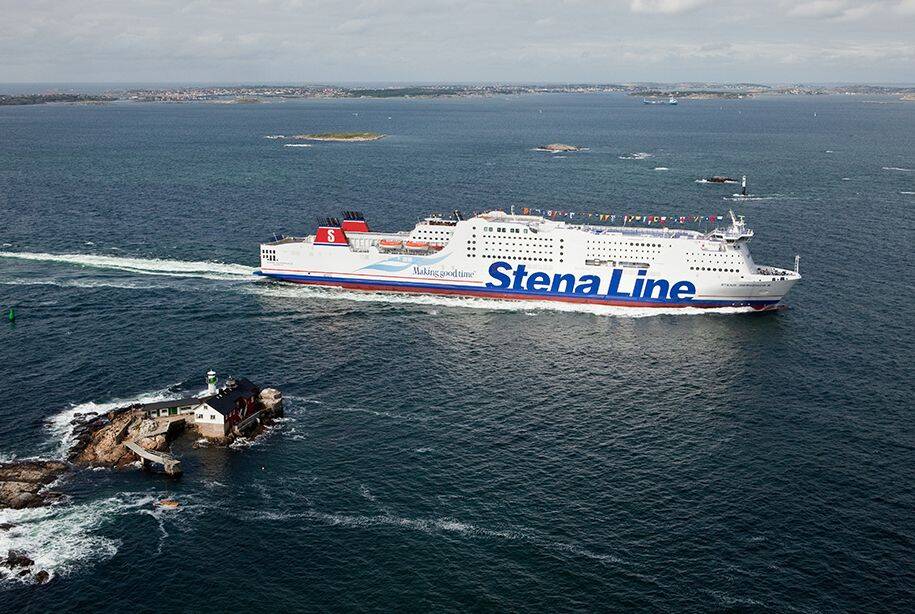
and onwards
1970
After many prosperous years, the shipbuilding industry began to lose competitiveness toward the late 1960s. Gothenburg, with its heavy reliance on large-scale manufacturing, was hit especially hard by the shipyard crisis of the 1970s. The major shipyards—Götaverken, Lindholmen, and Eriksberg—almost entirely disappeared from the city’s economy.
ÄLVSNABBEN
For those wishing to cross the Göta River by boat, Älvsnabben offers passenger service between the mainland and Hisingen.
CRUISES
Gothenburg has become a popular destination for cruise travelers.
THE PORT EXPANDS
West of the container terminal, Älvsborgshamnen was built for RoRo traffic in 1978.

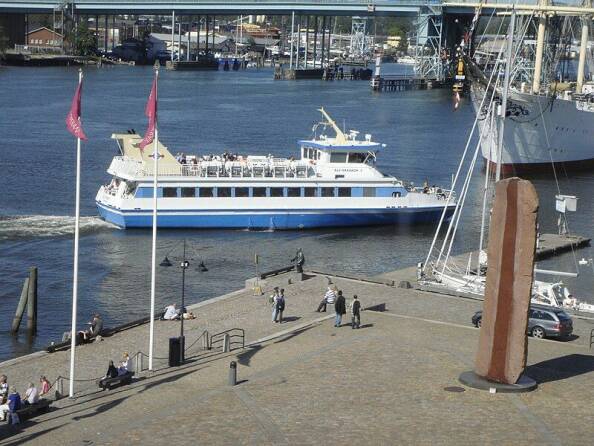
THE SHIPYARD CRISIS
During the 20th century, Sweden became one of the world's leading shipbuilding nations. The years during and just after World War II were highly profitable, and growth accelerated in the 1950s and 1960s. In Gothenburg, the three major shipyards—Götaverken, Eriksberg, and Lindholmen—all invested in increased capacity.
After many successful years, a downturn began in the late 1960s. Several factors contributed to the loss of competitiveness: rising costs, market share gained by countries like Japan and South Korea, and the oil crisis leading to fewer orders. Instead of scaling back, the shipyards continued to expand.
By the mid-1970s, the crisis was severe, prompting the Swedish government to intervene. In 1977, Svenska Varv AB (later Celsius AB) was established in an attempt to address the shipbuilding industry's problems, and the large Swedish shipyards were gradually taken over by the state. Lindholmen had already ceased production, but Götaverken and Eriksberg were acquired in 1978.
Svenska Varv couldn’t halt the decline, and the shipyard closures spread. Eriksberg ended new production in 1979, while Götaverken operated on a smaller scale during the 1980s. Götaverken Cityvarvet, however, continued and resumed operations in 1993.
Until 2015, the company was owned by Damen Shipyards Group, performing repairs, maintenance, and modifications on various vessels. Damen Shipyards went bankrupt in 2015, and the shipyard operations were ultimately closed.
ÄLVSBORG HARBOUR
The next major expansion of Gothenburg’s port took place in the late 1970s. West of the container terminal and inside New Älvsborg, Älvsborgshamnen was established in 1978 for RoRo (roll-on/roll-off) traffic, where all goods are loaded or towed aboard, often via trailer. From here, Stora Enso ships newsprint and other types of paper globally. Steel and cars are also significant goods passing through Älvsborgshamnen, now known as the RoRo Terminal, operated by DFDS and Cobelfret, two leading players in the European RoRo market.
ÄLVSNABBEN
Since the early 1990s, passenger traffic across the Göta River has resumed. The so-called Älvsnabben, operated by Styrsöbolaget on behalf of Västtrafik, connects the mainland and Hisingen with a zig-zag route between the Göta Älv Bridge and the Älvsborg Bridge. Stops include Lilla Bommen, Stenpiren, Lindholmspiren, Slottsberget, Eriksberg, and Klippan. Each ferry can carry around 450 passengers and accommodates bicycles as well.
From shipyard crisis to growing port
Stena Line is one of the world’s largest ferry operators. All Stena Line ferries shut off their engines and connect to shore power while docked at the Port of Gothenburg.
THE PORT OF GOTHENBURG BECOMES A COMPANY
For many years, port operations were managed by two municipal entities: the Port of Gothenburg Administration (Göteborgs Hamnförvaltning) and Gothenburg Stevedoring (Göteborgs Stuveri). Between 1967 and 1977, the stevedoring industry in Gothenburg was restructured from several stevedoring companies into a single entity, Göteborgs Stuveri AB, which also included the Dockworkers’ Office as a labor pool.
The aim of creating a unified port organization was achieved in 1985, when the port administration and stevedoring company merged to form the municipal company Göteborgs Hamn AB. This consolidation brought planning, construction, operations, and marketing under a single organization.
PASSENGER TRAFFIC
While cargo handling remains the primary activity of the Port of Gothenburg, the city has become an increasingly popular destination for passengers. As early as 1962, the first passenger route between Gothenburg and Skagen in Denmark was launched. The mastermind behind this venture was Sten A. Olsson, whose efforts eventually grew into the Stena Line empire. Tourists appreciate the cozy atmosphere of the city, its many cafes and restaurants, and the convenience of having most attractions within walking distance. Shopping, green parks, and the archipelago also receive high praise, while Liseberg amusement park remains a popular attraction for cruise and ferry travelers.
The increase in cruise calls is largely the result of a focused partnership between the Port of Gothenburg and Göteborg & Co, the city’s marketing and events company. Most cruise ships dock at the centrally located America Terminal, while the largest vessels moor at the Arendal Cruise Terminal near the Volvo Museum.
The port organizes for the future
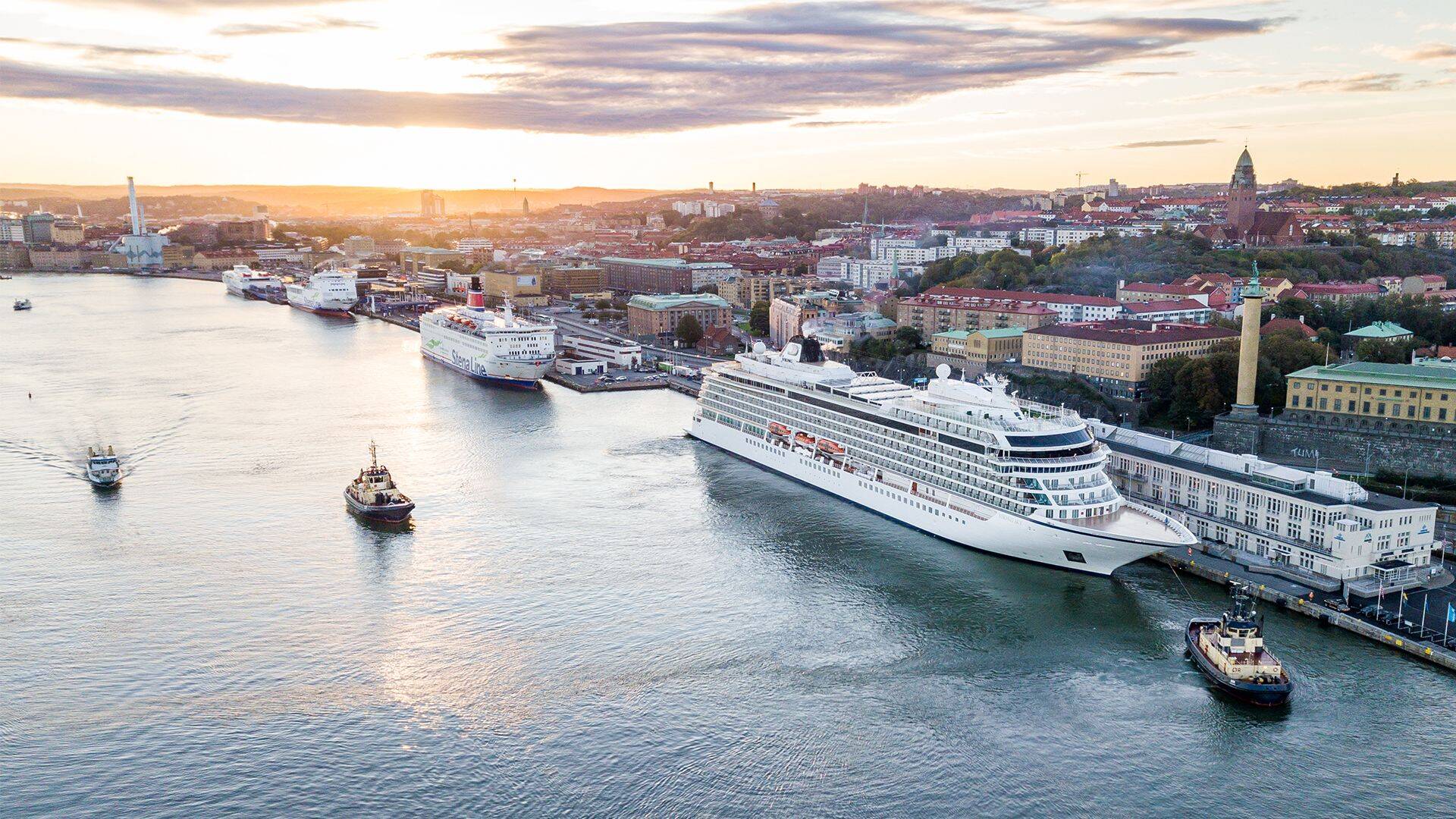
In the early 2000s, the Port of Gothenburg underwent major changes. The operations were divided into a municipal port company, The Port of Gothenburg, and four separate terminal companies. Quays, land, and infrastructure are owned by the municipality, while private operators manage the operations. This structure aligned the port with the setup of most major ports worldwide, laying the foundation for the Port of Gothenburg’s future direction.

A MUNICIPAL COMPANY - CITY OF GOTHENBURG
www.portofgothenburg.com

Today, the Port of Gothenburg is Scandinavia’s largest port, with a strong focus on sustainability and innovation. We offer modern facilities, global transport solutions, and a wide portfolio of services for both cargo and passenger traffic.
Discover more about our services and future opportunities by visiting our website—the future of transport and logistics starts here!
THE AMERICA TERMINAL
Göteborgs Hamn AB has its headquarters in the historic America Terminal (Amerikaskjulet). From the quay outside, emigrants departed from Gothenburg in the 19th century.
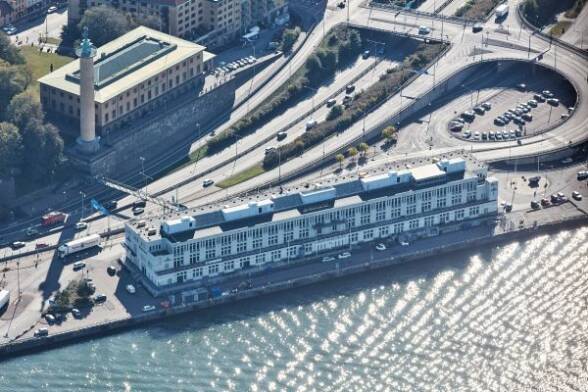
After the restructuring into a municipal company and separate terminal companies, Göteborgs Hamn AB moved its headquarters in 2011 from Sveas Kulle on Hisingen to the historic America Terminal at Stigbergskajen.
Throughout the 2000s, the port expanded in multiple areas. Gothenburg became a popular tourist destination, and the increase in cruises led to the establishment of a new cruise terminal in Arendal and the new America Terminal by the port headquarters, a historic site where Swedish America Line’s ocean liners once departed for New York until the 1970s.
Gothenburg is Sweden’s leading logistics hub, and on Hisingen, near the port, one of the country’s largest logistics parks has emerged: Port of Gothenburg Logistics Park. Simultaneously, the port continues to invest in efficient rail connections, resulting in Railport Scandinavia, one of the world’s premier rail solutions, ensuring reliable transport to and from the port from terminals across the country.
With increasing demand for cargo handling, new terminals are also being constructed, such as the rail-connected Arken Combi Terminal, where containers and trailers are transferred between trucks and trains. Sveaterminalen is being built with one of the world’s largest weather-protected storage tents, primarily for forestry products. Construction is also underway for an entirely new port terminal in Arendal, the largest port development project in Gothenburg in 40 years.
FOCUS ON THE ENVIRONMENT AND SUSTAINABLE TRANSPORTATION
The Port of Gothenburg is considered one of the world’s leading ports in environmental efforts. Climate-efficient rail transport, shore power for docked vessels, environmental discounts for eco-friendly ships, and the ability to bunker liquefied natural gas are examples of the port’s initiatives to reduce environmental impact.
The Port of Gothenburg is also the only Swedish port that can accommodate the world’s largest ocean-going cargo ships with direct routes to key global markets. As ships grow in size, the need to deepen the port increases. The massive Skandia Gateway project has begun, aiming to deepen a five-kilometer port area. This will enable the Port of Gothenburg to continue receiving the largest vessels in the future, offering sustainable logistics chains and efficient direct transport worldwide.
The port expands for the Future
and onwards
1970

ÄLVSNABBEN
For those wishing to cross the Göta River by boat, Älvsnabben offers passenger service between the mainland and Hisingen.
CRUISES
Gothenburg has become a popular destination for cruise travelers.
THE PORT EXPANDS
West of the container terminal, Älvsborgshamnen was built for RoRo traffic in 1978.


After many prosperous years, the shipbuilding industry began to lose competitiveness toward the late 1960s. Gothenburg, with its heavy reliance on large-scale manufacturing, was hit especially hard by the shipyard crisis of the 1970s. The major shipyards—Götaverken, Lindholmen, and Eriksberg—almost entirely disappeared from the city’s economy.

THE SHIPYARD CRISIS
During the 20th century, Sweden became one of the world's leading shipbuilding nations. The years during and just after World War II were highly profitable, and growth accelerated in the 1950s and 1960s. In Gothenburg, the three major shipyards—Götaverken, Eriksberg, and Lindholmen—all invested in increased capacity.
After many successful years, a downturn began in the late 1960s. Several factors contributed to the loss of competitiveness: rising costs, market share gained by countries like Japan and South Korea, and the oil crisis leading to fewer orders. Instead of scaling back, the shipyards continued to expand.
By the mid-1970s, the crisis was severe, prompting the Swedish government to intervene. In 1977, Svenska Varv AB (later Celsius AB) was established in an attempt to address the shipbuilding industry's problems, and the large Swedish shipyards were gradually taken over by the state. Lindholmen had already ceased production, but Götaverken and Eriksberg were acquired in 1978.
Svenska Varv couldn’t halt the decline, and the shipyard closures spread. Eriksberg ended new production in 1979, while Götaverken operated on a smaller scale during the 1980s. Götaverken Cityvarvet, however, continued and resumed operations in 1993.
Until 2015, the company was owned by Damen Shipyards Group, performing repairs, maintenance, and modifications on various vessels. Damen Shipyards went bankrupt in 2015, and the shipyard operations were ultimately closed.
ÄLVSBORG HARBOUR
The next major expansion of Gothenburg’s port took place in the late 1970s. West of the container terminal and inside New Älvsborg, Älvsborgshamnen was established in 1978 for RoRo (roll-on/roll-off) traffic, where all goods are loaded or towed aboard, often via trailer. From here, Stora Enso ships newsprint and other types of paper globally. Steel and cars are also significant goods passing through Älvsborgshamnen, now known as the RoRo Terminal, operated by DFDS and Cobelfret, two leading players in the European RoRo market.
ÄLVSNABBEN
Since the early 1990s, passenger traffic across the Göta River has resumed. The so-called Älvsnabben, operated by Styrsöbolaget on behalf of Västtrafik, connects the mainland and Hisingen with a zig-zag route between the Göta Älv Bridge and the Älvsborg Bridge. Stops include Lilla Bommen, Stenpiren, Lindholmspiren, Slottsberget, Eriksberg, and Klippan. Each ferry can carry around 450 passengers and accommodates bicycles as well.
From shipyard crisis to growing port
THE PORT OF GOTHENBURG BECOMES A COMPANY
For many years, port operations were managed by two municipal entities: the Port of Gothenburg Administration (Göteborgs Hamnförvaltning) and Gothenburg Stevedoring (Göteborgs Stuveri). Between 1967 and 1977, the stevedoring industry in Gothenburg was restructured from several stevedoring companies into a single entity, Göteborgs Stuveri AB, which also included the Dockworkers’ Office as a labor pool.
The aim of creating a unified port organization was achieved in 1985, when the port administration and stevedoring company merged to form the municipal company Göteborgs Hamn AB. This consolidation brought planning, construction, operations, and marketing under a single organization.
PASSAGERARTRAFIK
Varuhantering är den självklara huvudsysslan för Göteborgs hamn, men Göteborg har blivit ett allt mer populärt resmål för passagerare. Redan 1962 öppnade den första passagerarlinjen mellan Göteborg och Skagen i Danmark. Hjärnan bakom satsningen hette Sten A. Olsson och så småningom växer Stena Line till ett jätteimperium. Turisterna uppskattar den mysiga atmosfären
i staden, de många kaféerna och restaurangerna och det faktum att det är gångavstånd till det mesta. Även shoppingen får högt betyg, liksom de gröna parkerna och skärgården. Nöjesparken Liseberg är ett populärt resmål som också lockar många kryssnings- och färjeresenärer.
Ökningen av antalet kryssningsanlöp är till stor del ett resultat av målmedvetet samarbete mellan Göteborgs Hamn och Göteborg & Co, stadens marknadsförings- och eventbolag. De flesta kryssningsfartyg anlöper till centralt belägna Amerikaterminalen, men de allra största lägger till vid kryssningsterminalen Arendal vid Volvo museet.
The port organizes for the future

In the early 2000s, the Port of Gothenburg underwent major changes. The operations were divided into a municipal port company, The Port of Gothenburg, and four separate terminal companies. Quays, land, and infrastructure are owned by the municipality, while private operators manage the operations. This structure aligned the port with the setup of most major ports worldwide, laying the foundation for the Port of Gothenburg’s future direction.

Today, the Port of Gothenburg is Scandinavia’s largest port, with a strong focus on sustainability and innovation. We offer modern facilities, global transport solutions, and a wide portfolio of services for both cargo and passenger traffic.
Discover more about our services and future opportunities by visiting our website—the future of transport and logistics starts here!
THE AMERICA TERMINAL
Göteborgs Hamn AB has its headquarters in the historic America Terminal (Amerikaskjulet). From the quay outside, emigrants departed from Gothenburg in the 19th century.
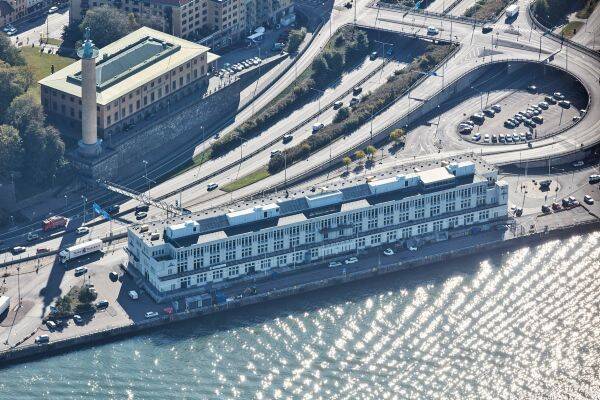
After the restructuring into a municipal company and separate terminal companies, Göteborgs Hamn AB moved its headquarters in 2011 from Sveas Kulle on Hisingen to the historic America Terminal at Stigbergskajen.
Throughout the 2000s, the port expanded in multiple areas. Gothenburg became a popular tourist destination, and the increase in cruises led to the establishment of a new cruise terminal in Arendal and the new America Terminal by the port headquarters, a historic site where Swedish America Line’s ocean liners once departed for New York until the 1970s.
Gothenburg is Sweden’s leading logistics hub, and on Hisingen, near the port, one of the country’s largest logistics parks has emerged: Port of Gothenburg Logistics Park. Simultaneously, the port continues to invest in efficient rail connections, resulting in Railport Scandinavia, one of the world’s premier rail solutions, ensuring reliable transport to and from the port from terminals across the country.
With increasing demand for cargo handling, new terminals are also being constructed, such as the rail-connected Arken Combi Terminal, where containers and trailers are transferred between trucks and trains. Sveaterminalen is being built with one of the world’s largest weather-protected storage tents, primarily for forestry products. Construction is also underway for an entirely new port terminal in Arendal, the largest port development project in Gothenburg in 40 years.
FOCUS ON THE ENVIRONMENT AND SUSTAINABLE TRANSPORTATION
The Port of Gothenburg is considered one of the world’s leading ports in environmental efforts. Climate-efficient rail transport, shore power for docked vessels, environmental discounts for eco-friendly ships, and the ability to bunker liquefied natural gas are examples of the port’s initiatives to reduce environmental impact.
The Port of Gothenburg is also the only Swedish port that can accommodate the world’s largest ocean-going cargo ships with direct routes to key global markets. As ships grow in size, the need to deepen the port increases. The massive Skandia Gateway project has begun, aiming to deepen a five-kilometer port area. This will enable the Port of Gothenburg to continue receiving the largest vessels in the future, offering sustainable logistics chains and efficient direct transport worldwide.
